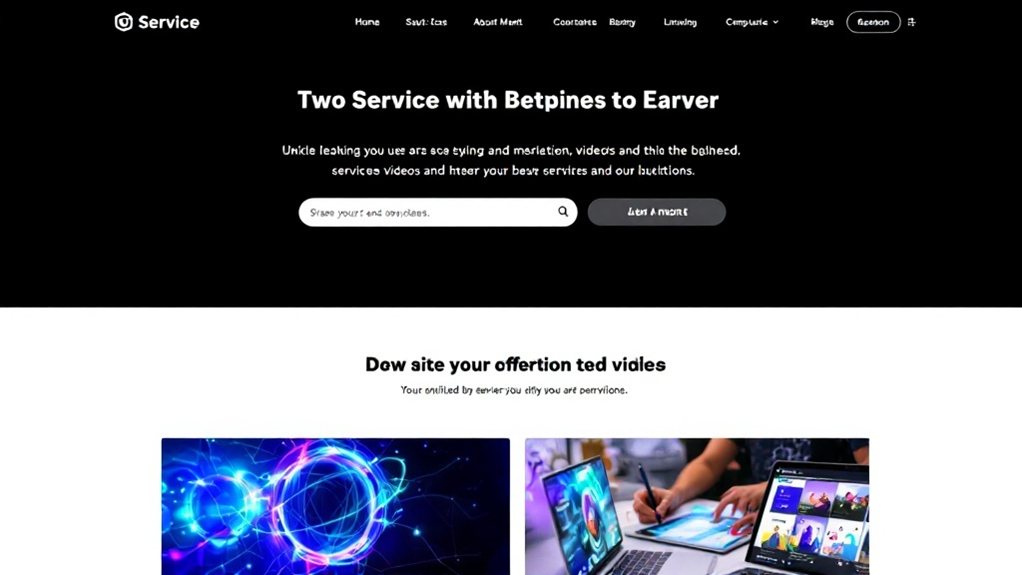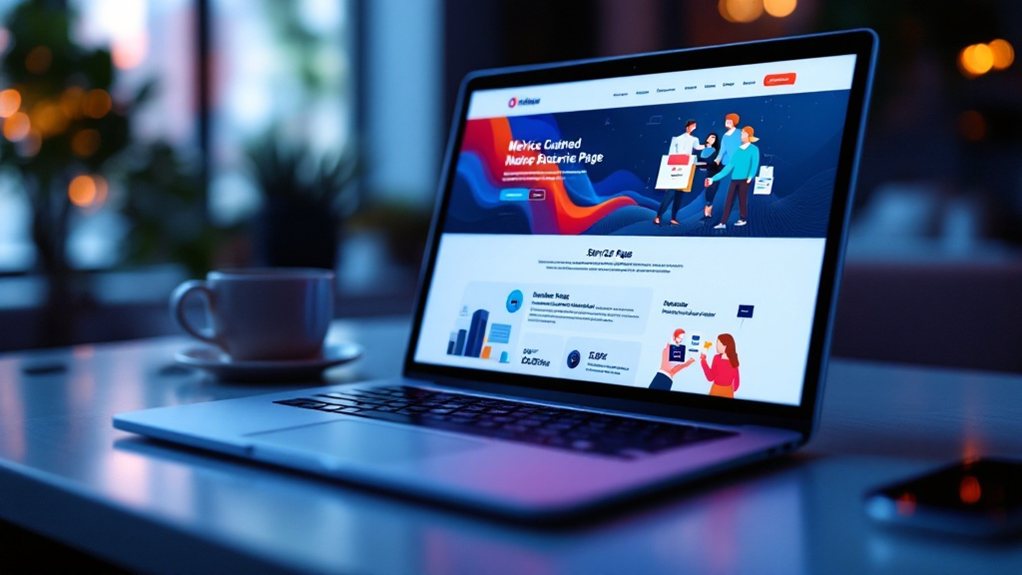High-quality, relevant visuals are essential for service pages, quickly grabbing attention and enhancing user understanding. Consistent branding through imagery reinforces your identity and builds trust. Optimized responsive images provide seamless experiences across devices. Aligning visuals with content simplifies complex offerings, while showcasing your services visually can drive engagement. Delving deeper, you'll discover how to leverage images and multimedia to create impactful, user-centric service pages that convert.
Visual Engagement Through Imagery

Although visual engagement is a fundamental component of effective web design, many businesses struggle to incorporate it seamlessly. Utilizing high-quality, relevant images is crucial for creating an immediate connection with your audience. Images simplify complex concepts, enhance understanding, and evoke emotions that strengthen the audience's connection to your brand. By strategically positioning visuals near important information, you can guide users towards your desired actions, boosting conversions. [Analyzing user interactions through heat maps can further inform design improvements, ensuring your visuals enhance the overall user experience and keep visitors engaged with your service pages.] Incorporating visuals that highlight the company's full lifecycle services and technologies, as seen in the Arcurve example, can effectively communicate your offerings.
Branding Consistency With Visual Elements

Consistent visual elements like logos, colors, and typography are crucial for building a strong brand identity. They reinforce your business's ethos, enhance recognition, and foster trust with your audience. Consistent branding helps people connect certain feelings and experiences with brand. Ensuring visual consistency across platforms is key to delivering a unified brand experience that reflects your values and offerings.
Consistent Brand Expression
As a business, you understand the power of visual consistency in building a recognizable and trustworthy brand. Consistent use of your logo, color palette, typography, and other visual elements across all your service pages and marketing channels reinforces your brand identity. This cohesive approach not only enhances brand recognition but also fosters customer loyalty and confidence. By maintaining a consistent visual expression, you can effectively communicate your brand's values and personality, ultimately driving engagement and conversion. Consistent branding can increase revenue by up to 20%. Leverage the benefits of consistent branding to create a seamless user experience and solidify your position in the market.
Visuals Reflect Business Ethos
Visual elements on your service pages don't just enhance the aesthetics – they reflect your business's ethos and values. Incorporating authentic images of your team and customers builds trust and showcases your brand's commitment to transparency. Consistent visual branding, from your logo to color palette, reinforces your professional identity and differentiates you from competitors. Moreover, visuals that align with your target audience's preferences and interests help forge an emotional connection, making your services more relatable and engaging. Images that showcase your product or service offerings can effectively communicate your brand's personality and values, strengthening your overall ethos and resonating with the right customers.
Perception and Comprehension With Images

Visuals have a powerful effect on how users perceive and comprehend content. Images can quickly grab attention and boost conceptual understanding, making complex topics more accessible. The picture-superiority effect can be leveraged to enhance the overall user experience on your service pages. Memorable visuals are more likely to be referenced and used in decision making.
Visual Attention Triggers
The human visual system is highly sensitive to certain perceptual features that can effectively grab our attention. Bright colors, distinctive shapes, and other salient stimuli trigger bottom-up, reflexive attention capture. Exogenous cues like these rapidly guide our focus, primed by visual characteristics. But semantic information also plays a key role. Meaningful words and objects activate rich representations, enhancing detection even when irrelevant to the task. Ambiguous objects are perceived differently depending on the context in which they are embedded. This parallel processing of perceptual and conceptual features allows context to modulate attention. Ultimately, understanding both bottom-up and top-down influences on visual attention is crucial for designing effective service pages that engage users.
Conceptual Understanding Boost
When you incorporate images into your content, you'll see a notable boost in conceptual understanding. Retention of information increases by 55% compared to text alone, and the brain processes visuals 60,000 times faster. Images create emotional connections, enhancing user engagement and communication of complex ideas. Additionally, pairing images with information can improve memory retention to 65% after three days. Images contribute to the storytelling process and enhance user experience with suitable, relevant content.
- Retain information up to 55% better.
- Process visuals 60,000 times faster than text.
- Evoke emotional connections and user engagement.
- Boost memory retention to 65% after three days.
Optimizing Images for Responsive Designs
Optimizing images for responsive designs is crucial to ensure a seamless user experience across various devices. By employing techniques like srcset and picture elements, you can serve the most appropriate image size based on screen resolution, reducing data consumption. Responsive images can dynamically adjust their dimensions, quality, and file size for optimal display across devices. Leveraging media queries, server-side resizing, and content delivery networks further enhances load times and accessibility, especially for mobile users. Additionally, choosing the right image format, compressing files, and removing metadata can significantly improve visual quality without compromising file size. Responsive images not only boost SEO performance but also increase customer engagement and lower bounce rates, delivering a cohesive experience across platforms. Harness the power of tools like ImageMagick and leverage lazy loading to elevate your service pages.
Aligning Images With Accompanying Content
Ensuring your images are contextually relevant and thoughtfully paired with accompanying content is key to delivering a cohesive and impactful service page experience. By aligning visuals with their supporting text, you can enhance the overall flow and clarity of your messaging, capturing your audience's attention and guiding them through your offerings. Leveraging effective image alignment techniques is a strategic way to elevate the visual appeal and effectiveness of your service page content. Properly sizing and positioning images on your service pages can also contribute to an optimal user experience.
Contextual Visual Relevance
Contextual visual relevance is paramount for elevating user engagement and crafting a cohesive experience. By aligning images with accompanying content, you can capitalize on enhanced user interest, relevant advertising, and real-time adaptability. Moreover, this privacy-compliant approach leverages AI and machine learning to ensure visual relevance without extensive data collection. Seamless integration of advertisements with the surrounding content creates a more cohesive and enjoyable browsing experience for users.
Consider these key benefits:
- Personalized experience
- Cost-efficient campaigns
- Cross-platform consistency
- Diverse format compatibility
Contextual visual relevance builds trust, optimizes image use, and reinforces your brand identity across channels. Stay ahead by embracing the latest AI-powered technologies supporting this strategic approach.
Complementary Content Pairing
Complementary content pairing takes the concept of contextual visual relevance a step further, enabling you to craft a more cohesive and engaging user experience. By aligning images consistently in your layout, you can enhance visual flow and ease user consumption. Normalizing aspect ratios and harmonizing colors across images further reinforces brand identity. While zigzag layouts may add interest, aligned designs often prove more scanning-efficient. Customized imagery, such as frames or overlays, can integrate visuals seamlessly into your content. Ultimately, purposeful pairing of informative images and relevant text optimizes engagement without overwhelming users.
| Consistency in Layout | Aspect Ratio Alignment | Color Harmonization |
|---|---|---|
| Enhances visual flow | Resolves disruptions | Aligns with brand |
| Improves consumption | Normalizes sizes | Enhances cohesion |
| Effective in columns | Constrains with CSS | Reinforces identity |
| Zigzag adds interest | Reduces efficiency | Customized effects |
| Aligned more scanning-friendly |
Leveraging Stock Photos and Illustrations
While stock photos can be a convenient and cost-effective solution, you'll want to leverage them strategically to avoid compromising your brand's authenticity. Consider these four key factors when using stock imagery:
- Complementary Integration: Pair stock photos with custom graphics or illustrations to create a unique visual style.
- Contextual Relevance: Ensure the stock images align with your target audience and the specific service page content.
- Moderation and Variety: Avoid overusing the same popular stock photos to maintain visual interest and differentiation.
- Accessibility and Inclusivity: Select diverse, inclusive stock imagery that represents your audience and resonates with their experiences.
Showcasing Products and Services With Visuals
Effectively showcasing your products and services through visuals is paramount in today's digital landscape. Leverage a range of visualization strategies to capture your customers' attention. Product visualizations, such as 2D and 3D images, allow you to highlight key features and customization options. Process visualizations, like flowcharts and journey maps, illustrate your service offerings. Interactive media, including augmented reality, enhances product engagement. Utilize 3D modeling for architecture and interior design, and provide customization tools to personalize products in real-time. Ensure your visuals align with user experience, refine them through iterative design, and integrate customer feedback to deliver impactful experiences that drive conversions.
Presenting Data and Information With Infographics
Infographics offer a powerful way to present complex data and information in a visually engaging manner. They transform dense figures and statistics into easy-to-digest visuals, enhancing comprehension and retention. Consider these key benefits of using infographics:
- Improve information recall by up to 400%
- Increase content engagement and shareability by 3 times
- Boost sales by up to 80% with the use of color
- Streamline the discovery of critical insights by 39%
Crafting effective infographics requires understanding your audience, using clear design, and selecting the right visual formats. By leveraging the storytelling power of infographics, you can captivate your audience and effectively communicate your data-driven insights.
Enhancing Interactivity With Multimedia Features
Interactive multimedia captivates audiences, blending text, audio, video, images, and animation to create immersive experiences. Features like polls and quizzes foster involvement, increasing content retention. Live streams boost engagement through real-time interactions, while interactive videos give users control over their viewing. AI-driven personalization enhances emotional resonance, driving engagement and conversion. To ensure effective implementation, define objectives, choose the right formats, and test across platforms. The benefits are clear – enhanced engagement, improved learning, wider accessibility, and better audience retention. Real-time features like live polls and monetization options further transform passive viewing into active participation. As AR/VR and gamification elements emerge, interactive multimedia will continue revolutionizing user experiences.
Designing Service Pages for Optimal User Experience
Designing effective service pages requires a keen focus on user experience. By adhering to key principles, you can create pages that engage and convert visitors. Start with a clean, simple design that aligns with your brand. Prioritize content structure, navigation, and information hierarchy to guide users effortlessly. Leverage interactive elements and multimedia strategically to enhance engagement. Lastly, measure performance regularly, gather user feedback, and optimize accordingly. This holistic approach ensures your service pages deliver an exceptional experience that drives results. Remember, great design and usability go hand-in-hand for effective service pages.
